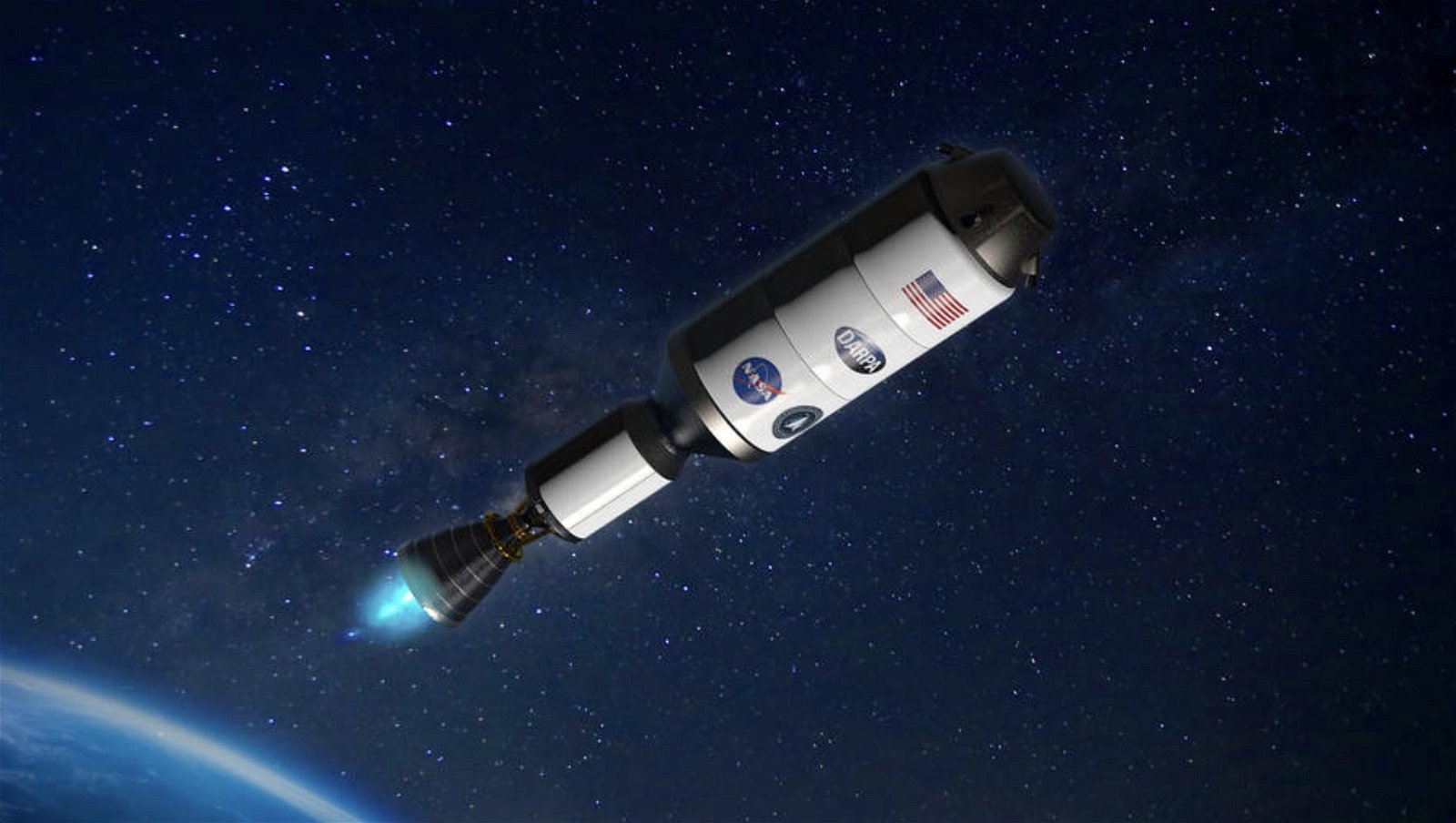

Welcome to this week’s installment of The Intelligence Brief… in recent days, NASA and DARPA have announced that they are joining forces to collaborate on a nuclear-powered spacecraft design that could take future generations of crewed space missions to distant planets. In our analysis, we look at 1) how this is the first time in 50 years that the U.S. government has explored such a concept, 2) what the joint NASA and DARPA program will entail, and 3) what nuclear-powered space propulsion may help humans accomplish with space travel in the decades ahead.
Quote of the Week
“The next door is opening. We have to go farther into space. But, before that, we need to develop far more improved nutrition and more advanced spacecraft.”
– Sunita Williams
Before diving into things, a few of the stories we’re covering right now include how a team of physicists says they have made a finding that could upset our current accepted understanding of the nuclear force. Elsewhere, Chris Plain provides us a debrief on the Top Five places humanity is most likely to find signs of extraterrestrial life and when those discoveries could take place. Also, Ukraine has been quietly carrying out strikes deep inside Russian territory using what appears to be a mysterious new type of kamikaze drones.
Meanwhile in video news, be sure to check out the latest episodes of Rebelliously Curious with Chrissy Newton, including her conversation with screenwriter and reporter Bryce Zabel, which airs on Friday. You can find all our other video content on our YouTube Channel. And lastly, be on the lookout in the coming days for some exciting new announcements about Debrief-related podcasts from our intrepid team of reporters, even more of which will soon be available on our site.
And with that, it’s time to get into our analysis of NASA and DARPA’s new plans to carry humans to Mars and beyond in the decades ahead, and how a nuclear thermal rocket might be the spacecraft that does it.
For the First Time in 50 Years, Nuclear Propulsion Spacecraft Concepts are On the Table
This week, it was revealed that plans for a nuclear thermal rocket are currently under development by the United States government, which could produce a novel spacecraft that may one day carry manned missions to Mars, marking the first U.S. tests involving such craft in half a century.
On Tuesday, the Defense Advanced Research Projects Agency (DARPA) and its partners with NASA announced a new collaboration, which the agencies say will enable crewed missions to the Red Planet in the decades ahead by demonstrating a new nuclear thermal rocket engine.
The project marks the first nuclear thermal rocket engine the United States has tested in five decades; the last similar tests occurred under NASA’s Nuclear Engine for Rocket Vehicle Application and Rover Projects.
NASA and DARPA to Join Forces
NASA and DARPA say they plan to collaborate on the forthcoming design of the Demonstration Rocket for Agile Cislunar Operations (DRACO) program, according to a statement that appeared at the space agency’s website on Tuesday.
NASA says it plans to cooperate in the development of the spacecraft with its partners at DARPA “to develop and demonstrate advanced nuclear thermal propulsion technology as soon as 2027,” the agency said in a press release. NASA says such technologies could help propel crewed missions to Mars faster than conventional technologies currently in use.


Relying on a fission reactor as its primary energy source, the high temperatures produced by the craft’s reactor are converted into a liquid form of propellant, producing an effective method of propulsion that is potentially three or more times as efficient as chemical rocket propulsion.
Nuclear thermal rocket propulsion offers several potential advantages over traditional chemical rockets; along with reduced travel time, nuclear-powered spacecraft help to ensure a safer, more efficient method of transit for astronauts on long-distance space missions. Such spacecraft also help to facilitate a larger payload capable of storing scientific instrumentation, as well as communications technologies.
Nuclear Thermal Powered Space Propulsion
NASA says that its Space Technology Mission Directorate will lead the development of the nuclear thermal engine, which it plans to combine with DARPA’s existing experimental spacecraft.
“DARPA will lead the overall program including rocket systems integration and procurement, approvals, scheduling, and security, cover safety and liability, and ensure overall assembly and integration of the engine with the spacecraft,” read a NASA statement. The agencies plan to unveil the experimental aircraft collaboration for its first demonstration in space before the end of the decade, possibly as early as 2027.
Jim Reuter, the associate administrator of NASA’s Science and Technology Mission Directorate, said the collaboration between NASA and DARPA will draw from both agencies’ past research into nuclear propulsion for use in space travel.


“Recent aerospace materials and engineering advancements are enabling a new era for space nuclear technology,” Reuter said, “and this flight demonstration will be a major achievement toward establishing a space transportation capability for an Earth-Moon economy.”
NASA Administrator Bill Nelson called the collaboration between his agency and DARPA “an exciting investment.”
“[W]e ignite the future, together,” Nelson said in a statement.
That wraps up this week’s installment of The Intelligence Brief. You can read past editions of The Intelligence Brief at our website, or if you found this installment online, don’t forget to subscribe and get future email editions from us here. Also, if you have a tip or other information you’d like to send along directly to me, you can email me at micah [@] thedebrief [dot] org, or Tweet at me @MicahHanks.


Here are the top stories we’re covering right now…
- Krypton-Fueled Ultra-Powerful Plasma Thrusters Could Drive Interplanetary Exploration
Ultra-efficient plasma thrusters, sometimes called ion thrusters or Hall thrusters, that are used almost exclusively in orbit could soon become much more powerful by using krypton gas instead of xenon.
- U.S. Air Force Awards Contract For Development of Secretive New Air-Launched Advanced Seeker
A new advanced seeker designed for maritime strike missions is currently in development, according to the United States Air Force and its division responsible for development of aerospace warfighting technologies.
- Mystery Killer of Crustaceans on UK Coast Linked to Unknown Pathogen, Government Report Says
A rash of “apocalyptic” crustacean deaths in recent months along England’s northeastern coast could involve an unknown pathogen, according to a new report
- Nuclear Force in Question as Physicists Report Observation That Could Challenge Our Current Understanding
A team of physicists says they have observed the most significant isospin mixing recorded to date during beta-decay experiments, a finding that could upset our current accepted understanding of the nuclear force.
- These Are the Top 5 Places and Times Humanity is Likely to Discover Extraterrestrial Life
Here are the Top Five places humanity is most likely to find signs of extraterrestrial life and when those discoveries could take place.
- Mysterious Ukrainian Kamikaze Drones Are Quietly Continuing to Launch Attacks Deep Within Russia
Ukraine has been quietly carrying out strikes deep inside Russian territory using what appears to be a mysterious new type of kamikaze drones.
- “Gravity Batteries” in Underground Mines Around the World Could Enable Long-Term Energy Storage
Scientists are looking at a novel new way of utilizing “gravity batteries” built from decommissioned mines for energy storage.
- China Says They Are Solving a Major Hypersonic Hurdle with Metamaterials and WiFi At hypersonic speeds, communication is impossible. Or, at least it was…
The Chinese government announced it has allegedly solved the issue of communication for hypersonic missiles and aircraft using WiFi and metamaterials.
- NASA’s Geotail Mission, Which Unraveled Auroras and Mysteries of Earth’s Magnetosphere, Finally Ends NASA Says Farewell to its Geotail Spacecraft After Three Decades of Service
NASA has announced that its Geotail spacecraft, a joint project with the Japanese Aerospace Exploration Agency (JAXA), has ended operations after three decades in orbit.
- The 2022 Annual Report on UAP: Four Significant Takeaways You Probably Missed
This week, our double-sized analysis will be focusing on four key takeaways you might have missed from the 2022 Annual Report on UAP.
- Transonic Experimental Aircraft in Development as NASA and Boeing Work to Produce New Sustainable Flight Demonstrator
A new transonic truss-braced wing (TTBW) aircraft design is in development, following an announcement from NASA that it has chosen Boeing to lead the design and production of a new full-scale demonstrator aircraft.
- Scientists Confirm Observation of Mysterious “Cherenkov Effect” in Two-Dimensional Space
Scientists in Israel have confirmed the first experimental observation of Cherenkov radiation while confined in two dimensions, according to new research.
